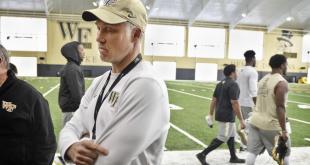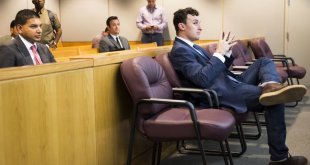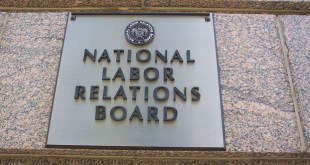College football season is in full swing, and that means a renewed interest in collegiate players trademarking their names and nicknames as well as increased conversation about pay-for-play. Unfortunately for players and proponents of compensating student-athletes, the Ninth Circuit’s decision in O’Bannon firmly shut the door on the possibility of the Olympic model.[i]
In August, an Associated Press story sparked a national conversation about NCAA athletes “looking to the future, seeking to own trademarks.” Unfortunately, due to current NCAA bylaws, players who seek federal trademark registrations are unable to capitalize on those marks until they go pro.
Presently, NCAA student-athletes are prohibited from profiting or even allowing others to profit from the use of their name, image, or likeness (“NIL”).[ii] Prior to the O’Bannon decision however, there was increased momentum to allow limited compensation through the Olympic model.[iii] There was even a prominent court case to pave the way.
Under the Olympic model, college athletes would receive money on individual deals, such as endorsements or autograph signings. That model would have allowed athletes to receive as much as the outside market would bear. When United States District Judge Claudia Wilken ruled in August, 2014 that the NCAA may not cap compensation to college athletes below $5,000 in deferred compensation per season, in order to comply with antitrust laws she paved the way for the Olympic model in the NCAA.
If Judge Wilken had not been overturned, it would be less of a “quantam leap” to go from $5,000 a year in deferred compensation to allowing student-athletes to place the profits of their trademarks into a deferred trust, since the seal of college athletes earning money beyond dollars “tethered to educational expenses” would have already been broken. However, language from the Ninth Circuit’s reversal on this point firmly shuts the door on that possibility – at least for the near future.
Two statements from the Ninth Circuit’s decision likely prevent the NCAA and its member institutions from allowing students athletes to profit from their trademarks.
“In finding that paying students cash compensation would promote amateurism as effectively as not paying them, the district court ignored that not paying student-athletes is precisely what makes them amateurs.”
“The difference between offering student-athletes education-related compensation and offering them cash sums untethered to educational expenses is not minor; it is a quantum leap.”
These quotations make clear, at least for the moment, that if student-athletes are compensated above the full cost of attendance by educational institutions, the NCAA risks losing its most powerful procompetitive justifications, and is possibly removed from the rule of reason analysis all together.[iv]
Additionally, language in Judge Wilken’s proposal prevents third parties from filling the NCAA void and paying athletes directly. In August, 2014, Judge Wilken ruled that, “allowing student-athletes to receive money for endorsements — does not offer a less restrictive way for the NCAA to achieve its purposes.” So as it stands right now, the law prohibits the Olympic model from moving forward.
If Student-Athletes Can’t Profit From Their Trademarks, Should They Bother Seeking Federal Registration?
Absolutely, yes! Federal registration of trademarks is relatively inexpensive and provides several important benefits. Registering a trademark for a single class of goods or services can cost as little as $225. Even including the cost of an attorney, registering a single mark should cost less than $1,000. While that is certainly a lot of money to a college student, it is well worth the investment.
Federal registration provides several important benefits, but when it comes to college athletes, the most important benefits are priority, presumption of ownership and the exclusive right to use the mark nationally.
Additionally, because student-athletes are prohibited from profiting off their likeness it may be the only way for an individual to ensure the right to use and profit from the mark after graduating or going pro. This is because trademark rights are based first and foremost on use. With one exception, the first to use a mark in commerce is the rightful owner of the mark. That exception is filing an application for federal registration, which, upon registration, confers a constructive date of first use.
Since student-athletes can’t use the mark in commerce without losing their eligibility, the only path to secure rights in a trademark is to file an intent-to-use application. An intent-to-use application essentially allows the student-athlete to call dibs on the ability to use the applied for trademark. From the date the application is filed, the student-athlete’s dibs can last between three and four years.[v] Given the requirement that college football players be three years removed from high school before entering the NFL Draft, the intent-to-use application is an ideal solution for players seeking to preserve trademark rights in their names and nicknames.
Unfortunately, for many collegiate athletes the window of time to capitalize on their fame lies directly in this three-year period where they are prevented from capitalizing on their name. This is because even if the player is skilled enough to be drafted, he is not likely to be among the best players on his team at the next level, and his commercial appeal may be limited. Moreover, the athlete would be viewed in an entirely different market with new fans who are less likely to purchase goods with his trademark. For example, in Provo, Utah in 2011, Jimmer Fredette was without a doubt the definition of Big Man on Campus. Whereas in modern day San Antonio he is just a journeyman backup.
Or, consider Jeremy Lin and “Linsanity.” If his fifteen minutes happened while he was in college, he would have been unable to market and capitalize on that fleeting fame.
Lessons from Collegiate Athlete Trademarks
Two former and two current college football players provide excellent examples of why student-athletes should consider filing for trademark protection while they are still in school.
The first is Johnny Manziel. In the fall of 2012, as a redshirt freshman, Manziel took the college football world by storm on his way to winning the Heisman Memorial Trophy. As soon as Johnny Football mania took hold in College Station, merchandise bearing Manziel’s nickname also began to pop up. Because in most instances the merchandise, in particular shirts, incorporated elements of the University’s trademarks as well, the school sent cease and desist letters to people marketing “Johnny Football” merchandise.
This is often the case. Remember Tyrann Mathieu and his “Honey Badger” nickname? In 2011, LSU sent several cease and desist letters to people marketing Honey Badger merchandise. Schools are protecting not only their own marks, but are also protecting the eligibility of the students. The sale of products including the name, likeness or image of student-athletes is a violation of NCAA Bylaw 12.5.2.2 and can result in the student losing their eligibility.
Mathieu never filed for trademark protection. Manziel did, but he made several mistakes, including waiting until after the season was over in February 2013 (technically, JMAN2 Enterprises LLC, a company registered to Manziel’s family filed for the trademark). By this time, numerous individuals were already selling Johnny Football merchandise and one individual even filed a trademark application for the mark “Johnny Football.”[vi]
Manziel’s delay in filing a trademark application demonstrates the importance of acquiring a trademark registration. First, as stated above, trademark rights result first from use and second from filing an application. Since Manziel can’t demonstrate use without losing his NCAA eligibility he must file a trademark application to obtain priority. Although the law prohibits the registration of a mark which “consists of or comprises a name, portrait, or signature identifying a particular living individual except by his written consent,”[vii] it is unwise to rely on the trademark office to realize that an applied-for mark is referring to a collegiate athlete.
In fact, that’s exactly what happened in Manziel’s case. A trademark application filed by Kenneth R. Reynolds Family Investments on November 1, 2012 went nearly ten months before the examiner realized that the mark identified Manziel and issued a refusal.
Manziel (or rather, his attorney) made another mistake by filing the application without Manziel’s written consent, and more importantly by filing under section 1(a) which is for marks already in use in commerce. Collegiate athletes cannot allow the sale of products bearing their NIL without losing their eligibility, therefore, they cannot meet the requirements of section 1(a) which requires the sale of goods/services in commerce. Moreover, filing under section 1(a) will trigger a refusal by the examining attorney as “merely ornamental” if the application is for athletic apparel (as most of these trademark applications are). This is because t-shirts and other apparel which bear larger designs or slogans are not considered to function as source indicators. For example, a small swoosh, or a polo player on the pocket or breast area of a shirt serve the trademark function, other marks are considered to be “merely ornamental.”
The merely ornamental issue can be overcome in two ways. First, Manziel should have filed his application under section 1(b) for intent to use. This delays the need for a specimen showing how the mark is used on the goods and allows for the student-athlete to reserve trademark rights while maintaining eligibility. The second way to overcome this is to put the mark on the tag of the shirt.
Coinciding with Manziel’s delay in seeking trademark registrations was his decision to file suit against two individuals marketing “Johnny Football” merchandise.[viii] Manziel eventually settled the lawsuits, and the NCAA allowed him to retain the earnings without losing his eligibility. However, the NCAA made clear that this was not a loophole allowing boosters to infringe trademarks in order to pay athletes.[ix]
For various reasons, Manziel, now entering his second professional season, has yet to obtain a registration for the “Johnny Football” mark (although the application should be published for opposition and eventually register within the next year). Nevertheless, the timing further demonstrates the importance of filing early and properly, as well as the need to involve an attorney from the outset.
Beyond Manziel, two current college football stars have also registered for trademarks this year. Missisippi State quarterback Dak Prescott and Ohio State running back Ezekiel Elliot.
In August, 2015, Ezekiel Elliott applied for five different trademarks: “Hero in a Half Shirt,” “In Crop We Trust,” “EZE,” “Zeke,” and “Zeke’s Crop Top Bar and Grill.” Elliot smartly applied using section 1(b) “intent to use” enabling him to obtain priority without having to use his name in commerce and jeopardize his eligibility. However, for all but the “Bar and Grill” mark he is seeking a trademark for athletic apparel and will likely run into “merely ornamental” issues in the future. Beyond that, phrases and slogans can be difficult to register, especially for apparel.
If Elliott can afford to file for this many marks and afford to fight the trademark office in an attempt to register these marks, then he certainly should. But, for other student-athletes this may not be feasible.
In November 2014, Dak Prescott applied for two trademarks: “Dak Attack,” and “Dak Prescott.” In February, 2015, he applied for the mark “Who Dak.” Each of the applications is for both apparel as well as educational and entertainment services. The two marks applied for in November have moved to the “Notice of Allowance” stage where Prescott is required to either submit examples of his use of the mark in commerce, or seek an extension of time. In order to maintain his eligibility, he will seek an extension, and may do so up to five times. Prescott’s applications demonstrate smart use of the trademark system to secure rights to his name and nickname.
Is Registration Really Necessary?
No. It is not absolutely necessary for students to file for trademark registrations, but it sure is smarter than the alternative.
Having a trademark registration isn’t necessary for several reasons. First, the right of publicity will in most instances protect the student’s NIL rights from potential infringers. Second, Trademark Act Section 2(c) should prevent the unauthorized registration of marks identifying the student-athlete. Third, most uses of the student’s likeness will infringe his university’s marks as well.
But, the right of publicity varies from state to state, trademark examiners are not all big college football fans, and not every “Johnny Football” shirt will infringe Texas A&M’s trademarks. Moreover, phrases that identify the athlete receive less protection than their actual name.[x] Assuming the student-athlete, or his family can afford it, the upfront investment in a trademark application is well worth it.
Additionally, it would be wise for athletes to seek domain names for their various marks. A domain name can be registered with ease and for only $10 a year. Although there are laws in place to prevent cyber-squatting, domain name speculation is alive and well and it can be difficult to legally force a sophisticated speculator to give up the domain name.
Takeaways
The Ninth Circuit’s decision in O’Bannon is a big blow to supporters of the Olympic model and for athletes seeking to monetize their names, and nicknames through trademarks. However, for those student-athletes that can afford to, it is still wise to seek federal trademark registrations. Despite the court’s ruling and no Olympic model, a player is still allowed to retain the financial earnings as a result of a legal action. Combined with the benefits of priority, presumption of ownership and the exclusive right to use the mark nationally, a federal registration is an absolute must.
[i] For more on why the O’Bannon appeal was a win for the NCAA see Jeremy Jarrett’s explanation.
[ii] See, NCAA Bylaws, 12.01.1; 12.4.4; 12.5.2.1; and 12.5.2.2.
[iii] The Pac-12 has even introduced a proposal to allow student-athletes to use their names, images, and likenesses to promote their own non-athletic business ventures. It wouldn’t allow athletes to cash in on trademarks for their nicknames, but it’s a step in that direction.
[iv] Simply being in the rule of reason analysis as opposed to the stricter quick-look or deadly per se unlawful rule is extremely beneficial to the NCAA. The vast majority of rule of reason cases find the defendant’s conduct to be net procompetitive and thus legal.
[v] An intent to use application, can be approved for registration in six months to a year. Once an intent to use application has been approved the trademark office issues a “Notice of Allowance” which requires the applicant to file a “Statement of Use” within six months which states that there is no longer intent to use, but rather actual use in commerce. However, the applicant may delay this filing up to five times for a total of 36 months of delay following issuance of the Notice of Allowance.
[vi] The application was filed on November 1, 2012 by Kenneth R. Reynolds Family Investments, LP. The USPTO filed a notice of abonnement on October 16, 2014.
[vii] 15 U.S.C. §1052(c).
[viii] JMAN2 Enterprises v. Vaughan, United States District Court for the Eastern District of Texas: Complaint, February 15, 2013; and JMAN2 Enterprises v. Doolan, United States District Court for the Eastern District of Texas: Complaint, March 1, 2013.
[ix] See, “NCAA is Watching Johnny Manziel’s Trademark Lawsuit for Possible Violations.”
[x] Just ask Terrell Suggs, who was unable to obtain registration for “Ball So Hard University.”
 The Sports Esquires Putting Sports on Trial
The Sports Esquires Putting Sports on Trial





2 comments
Pingback: Sports Law Links | The Sports Esquires
Pingback: 2015 Sports Law Year in Review - The Sports Esquires